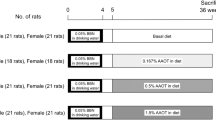Summary
Whereas disulfiram (DSF) is known to inhibit tumor formation resulting from a number of chemical carcinogens, such inhibition does not apply to nitrosamines. In the present study, biochemical and morphological findings were examined to elucidate the effect of DSF on long-term application of N-nitroso-N-methylbenzylamine (NMBA). HPLC and fluorescence detection were used to determine O6-methylguanine (O6-MG) in DNA obtained from the respiratory tract of rats subjected to long-term simultaneous application of DSF and NMBA. After 2 days of treatment, more O6-MG was detected in the proximal portion of the respiratory tract, including the trachea and main bronchi, than in the distal portion. The findings were reversed after 10 and 30 days, at which time formation of the DNA adduct was substantially higher in the distal portion of the respiratory tract, despite increases in both portions. The biochemical results corresponded to morphological findings. Initially, mereased numbers of metabolizing goblet cells appeared in mucous cell hyperplasia in the proximal respiratory tract. Subsequently, the hyperplasia migrated to distal regions of the respiratory tract; at this stage, the goblet cells disappeared from the proximal portion, which now revealed toxic degeneration, atrophy and subsequent squamous metaplasia of the mucous lining and squamous papillomas.
At various times during a 40-day period, 2 to 7 times more O6-MG in pulmonary DNA was detected in rats treated with DSF and NMBA, than with NMBA alone, whereby distinct amounts of O6-MG were found in the latter animals. In contrast to the above-mentioned morphological findings, no morphological alterations occurred in the respiratory tract of the animals treated with NMBA alone. It is therefore conceivable that the above pathological lesions resulted not merely from the presence of DNA adducts, but also from an additional, previously unspecified effect.
As benzaldehyde (BA) is formed in equimolar amounts in NMBA metabolism and DSF has been demonstrated to inhibit aldehyde metabolism, this aldehyde is a possible candidate for such an effect. In the present study, rats were therefore treated with BA, DSF, or NMBA, or combinations thereof. Histomorphological evaluation of these experiments revealed that long-term application of BA alone led to the following alterations in the respiratory tract: goblet cell hyperplasia, hyperplasia of the peribronchial lymphatic system, mucous epithelial atrophy and accompanying peerivasculitis — the same alterations seen under long-term application of NMBA and DSF. Furthermore, these changes were most pronounced in the group with concomitant application of NMBA, DSF, and BA. It is therefore conceivable that BA plays a role in pathological changes observed under the influence of NMBA.
Similar content being viewed by others
References
Boyd MR (1977) Evidence for the Clara cell as a site of cytochrome P-450-dependent mixed-function oxidase activity in lung. Nature 269:713–715
Bürkle V (1985) Experimenteller Beitrag zur Tumorgenese im Respirationstrakt. Habilitationsschrift, Universität Tübingen
Bürkle V, Wittenberg H, Schweinsberg F, Weißenberger I, Schweinsberg E, Brückner B (1984) Role of the respiratory system in metabolism of N-nitrosamines after simultaneous application of disulfiram. In: O'Neill IK, von Borstel RC, Miller CT, Long J, Bartsch H (eds) N-Nitroso compounds: occurrence, biological effects and relevance to human cancer. IARC Scientific Publications No. 57, Lyon, France, pp 533–541
Fiala ES (1981) Inhibition of carcinogen metabolism and action by disulfiram, pyrazole and related compounds. In: Zedeck MS, Lipkin M (eds) Inhibition of tumor induction and development. Plenum Press, New York, pp 23–69
Garschin WG, Schabad LM (1936) Über atypische Wucherungen des Bronchialepithels bei Einführung von Formalin in das Lungengewebe. Z Krebsforsch 43:137–145
Grafstrom RC, Fornace AJ, Autrup H, Lechner JF, Harris CC (1983) Formaldehyde damage to DNA and inhibition of DNA repair in human bronchial cells. Science 220:216–218
Hodgson RM, Wiessler M, Kleihues P (1980) Preferential methylation of target organ DNA by the oesophagial carcinogen N-nitrosomethylbenzylamine. Carcinogenesis 1:861–866
Horton AW, Tye R, Stemmer KL (1963) Experimental carcinogenesis of the lung. Inhalation of gaseous formaldehyde or an aerosol of coal tar by C3H mice. J Natl Cancer Inst 30:31–43
Kraft PL, Skipper PL, Tannenbaum SR (1980) In vivo metabolism and wholeblood clearance of N-nitrosomethylbenzylamine in the rat. Cancer Res 40:2740–2742
Labuc GE, Archer MC (1982) Esophageal and hepatic microsomal metabolism of N-nitrosomethylbenzylamine and N-nitrosodimethylamine in the rat. Cancer Res 42:3181–3186
Otto H, Wagner H (1956) Beitrag zur Frage der Regeneration des Bronchialepithels. Beitr Pathol Anat 116:436–460
Pegg AE, Perry W (1981) Alkylation of nucleic acids and metabolism of small doses of dimethylnitrosamine in the rat. Cancer Res 41:3128–3132
Reznik-Schüller HM, Gregg M (1981) Pathogenesis of lung tumors induced by N-nitrosoheptamethyleneimine in F 344 rats. Virchows Arch 393:333–343
Reznik-Schüller HM, Hague BF Jr (1981) Autoradiographic study of the distribution of bound radioactivity in the respiratory tract of Syrian hamsters given N-(3H)nitrosodiethylamine. Cancer Res 41:2147–2150
Schmähl D, Krüger FW, Habs M, Diehl B (1976) Influence of disulfiram on the organotropy of the carcinogenic effect of dimethylnitrosamine and diethylnitrosamine in rats. Z Krebsforsch 85:271–276
Schweinsberg F, Bürkle V (1981) Wirkung von Disulfiram auf die Toxizität und Carcinogenität von N-Methyl-N-nitrosobenzylamin bei Ratten. J Cancer Res Clin Oncol 102:43–47
Schweinsberg F, Weißenberger I, Brückner B, Schweinsberg E, Bürkle V, Wittenberg H, Reinecke HJ (1984) Effect of disulfiram on N-nitroso-N-methylbenzylamine metabolism. Biochemical aspects. In: O'Neill JK, von Borstel RC, Miller CT, Long J, Bartsch H (eds) N-Nitroso compounds: occurrence, biological effects and relevance to human cancer. IARC Scientific Publications No. 57, Lyon, France, pp 525–532
Author information
Authors and Affiliations
Additional information
Supported by Breuninger Stiftung, D-7000 Stuttgart; AWG-Analysen-Geräte GmbH, D-7970 Leutkirch, FRG; Asta-Werke AG, D-6000 Frankfurt am Main. FRG; Cyanamid GmbH, D-8190 Wolfratshausen, FRG, Farmitalia Carlo Erba GmbH, D-7800 Freiburg i Br., FRG
Rights and permissions
About this article
Cite this article
Schweinsberg, F., Danecki, S., Grotzke, J. et al. Modifying effects of disulfiram on DNA adduct formation and persistence of benzaldehyde in N-nitroso-N-methyl-benzylamine-induced carcinogenesis in rats. J Cancer Res Clin Oncol 112, 75–80 (1986). https://doi.org/10.1007/BF00404385
Received:
Accepted:
Issue Date:
DOI: https://doi.org/10.1007/BF00404385




